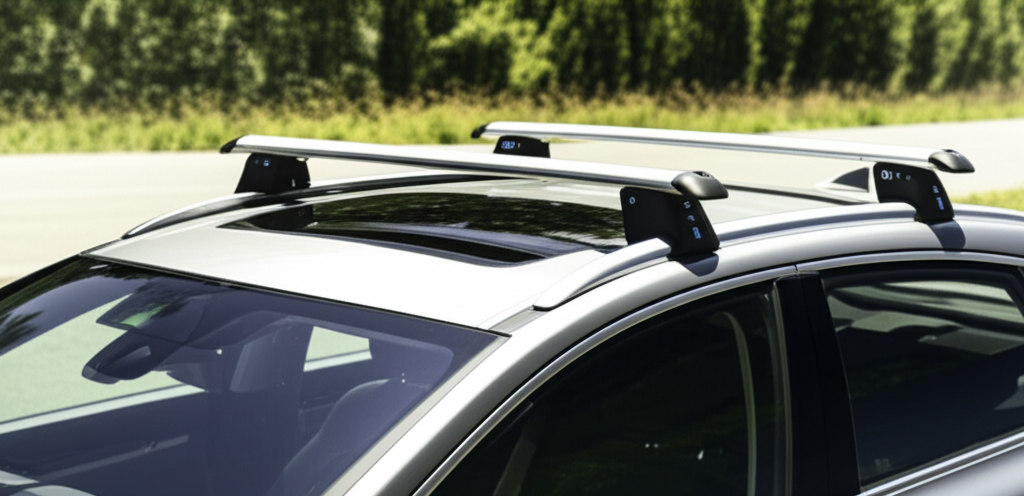Quick Summary: You can buy a roof rack for your car at dedicated auto parts stores (both online and brick-and-mortar), large automotive retailers, specialized outdoor adventure shops, and directly from vehicle manufacturers or their authorized dealers. Your best bet is often online retailers for selection and price, or a physical store for immediate needs and expert advice.
Hitting the road for an adventure often means packing more gear than your car’s trunk can handle. Whether you’re heading for a camping trip, a ski vacation, or just need extra space for a move, a roof rack can be a game-changer. But where do you even start looking when you need to buy one? It can feel a bit overwhelming with all the options out there. Don’t worry, I’m here to walk you through it, step by step, making sure you find the perfect fit for your car and your lifestyle. We’ll cover all the top spots to find a reliable roof rack, so you can start planning your next getaway with confidence.
Understanding Your Roof Rack Needs
Before you even start thinking about where to buy, it’s smart to know what kind of roof rack you actually need. This will save you time and prevent you from buying something that won’t work for your vehicle or your gear. The main styles are:
- Bare Roof Racks: These are designed for cars with no existing roof rails or gutters. They typically use clips or clamps that attach to your car’s door frames. They’re versatile but might not always offer the highest weight capacity.
- Side Roof Rails: These run along the length of your car’s roof, sticking up slightly. Many aftermarket racks attach directly to these rails using specific mounts.
- Flush Roof Rails: Similar to side rails, but they sit directly on the roof surface without a large gap. Racks mount to these using specialized feet.
- Factory-Installed Crossbars: Some cars come with crossbars already installed, often connected to side rails. If you have these, you’ll likely just need accessories that attach to the crossbars.
- Rain Gutter Racks: Older vehicles, and some SUVs or vans, have a distinct rain gutter along the edge of the roof. Special racks clamp onto these.
Consider what you’ll be carrying. Are you hauling skis, a kayak, a rooftop tent, or just a few extra suitcases? The weight and shape of your cargo will influence the type of rack and the specific accessories you’ll need. Always check your car’s owner’s manual for information about your roof’s load capacity. For example, the National Highway Traffic Safety Administration (NHTSA) provides guidelines on vehicle safety, and understanding your car’s limitations is part of that.
Where Can I Buy a Roof Rack for My Car? Your Essential Guide
Finding the right place to buy a roof rack is key to getting the best product for your needs at a fair price. Let’s break down the most common and reliable places:
1. Online Automotive Retailers

This is often your best bet for selection, competitive pricing, and customer reviews. You can compare dozens of brands and models from the comfort of your home.
- Amazon: The giant of online retail. You’ll find a massive selection of brands, from well-known manufacturers like Thule and Yakima to more budget-friendly options. The advantage here is the sheer volume and the wealth of customer reviews, which can be incredibly helpful for determining fit and quality.
- REI (Recreational Equipment, Inc.): REI is a fantastic resource if you’re into outdoor adventures. They carry a curated selection of high-quality racks from brands like Thule and its own brand. Their staff are generally very knowledgeable, and while they have physical stores, their online presence is robust.
- Backcountry.com: Similar to REI, Backcountry focuses on outdoor gear and is a great place to find reputable roof rack brands suitable for serious adventurers.
- Specialty Online Rack Stores: Websites like RackAttack.com, RoofRackGuys.com, and others specialize solely in roof racks and related accessories. These sites often have incredibly detailed fit guides and expert advice readily available.
Pros: Huge selection, competitive pricing, detailed product information and reviews, convenient home delivery.
Cons: Can’t physically see or touch the product before buying, potential for incorrect fitment if you’re not careful with online guides, can’t take it home immediately.
2. Brick-and-Mortar Auto Parts Stores
These are the classic go-to places for car parts and accessories. They offer the advantage of seeing products in person and getting advice from staff.
- AutoZone: A national chain with a wide variety of auto parts. They usually stock popular brands of roof racks and have knowledgeable staff who can help you find the right fit for your car.
- Advance Auto Parts: Another major player in the auto parts scene. Similar to AutoZone, they offer a good selection and can provide assistance with fitment.
- O’Reilly Auto Parts: Known for its knowledgeable staff and extensive inventory, O’Reilly’s is a solid choice for browsing roof racks in person.
- Pep Boys: Offers auto parts, tires, and service. You can often find a decent selection of roof rack systems here.
Pros: Ability to see and touch the product, immediate purchase and take-home, knowledgeable staff for immediate questions, convenient locations.
Cons: Selection might be more limited than online, pricing can sometimes be higher than online retailers.
3. Specialty Outdoor and Sports Retailers
If your primary use for a roof rack is for outdoor sports like biking, skiing, or kayaking, these stores are excellent places to shop.
- REI (again): As mentioned, REI is a top-tier choice for outdoor enthusiasts. They understand the need for reliable gear that can withstand various conditions.
- Dick’s Sporting Goods: While not their primary focus, Dick’s often carries a selection of car racks and accessories, especially those geared towards common sports like skiing and cycling.
- Local Bike Shops / Ski Shops: Many local specialty shops carry high-quality racks and are staffed by people who are passionate about the sports they serve. They can offer very specific advice for your gear.
Pros: Expert advice tailored to specific sports, often carry high-quality, durable brands, can often see your specific gear (bike, skis) displayed with rack systems.
Cons: Selection might be limited to brands they carry, potentially higher prices due to specialization.
4. Car Dealerships (OEM Parts)
Your car’s manufacturer often offers their own branded roof rack systems, designed specifically for your make and model.
- Your Local Car Dealership: You can order OEM (Original Equipment Manufacturer) roof racks directly from the dealership for your specific vehicle. These are guaranteed to fit.
Pros: Perfect fitment and integration with your car’s design, often high quality and durable, installed by professionals if you choose. Some might even be covered under your vehicle’s warranty.
Cons: Typically the most expensive option, selection is limited to what the manufacturer offers (may not suit all cargo types). Installation might cost extra.
5. Used Marketplaces
For budget-conscious shoppers, the used market can be a treasure trove, but it requires more caution.
- Craigslist / Facebook Marketplace: You can find great deals on used roof racks. However, it’s crucial to inspect the rack thoroughly for damage, rust, or missing parts. Ensure it’s compatible with your car model, and be wary of deals that seem too good to be true.
- eBay: Offers a wider reach than local classifieds and often has more detailed listings, including options for used and refurbished racks.
Pros: Significantly lower cost, can find discontinued or hard-to-find models.
Cons: No warranty, risk of hidden damage, requires careful inspection, fitment confirmation is critical, often sold as-is.
Essential Factors to Consider Before You Buy
Once you know where to look, keep these points in mind to make the best purchase:
Vehicle Compatibility
This is the MOST important factor. A rack designed for one car won’t fit another. You need to know your car’s year, make, and model, and whether it has existing roof rails, flush rails, or a bare roof. Many online retailers and auto parts stores have a “fit guide” or “vehicle selector” tool on their website or in-store. Use it! A good fit ensures safety and prevents damage to your vehicle.
Type of Cargo
What are you hauling?
- Bicycles: You’ll need bike mounts that attach to the rack.
- Skis/Snowboards: Ski/snowboard carriers are designed to hold them securely, protecting them from the elements.
- Kayaks/Canoes: Kayak carriers (J-cradles or stackers) are specialized to prevent scratching and ensure stability.
- Luggage/Cargo Boxes: These are enclosed boxes that offer weather protection and security for luggage, camping gear, etc.
- Roof Top Tents: These are heavy-duty and require a rack system with a high weight capacity.
The type of cargo will dictate the accessories you need, and sometimes the base rack system itself.
Weight Capacity
Every roof rack and your car’s roof have a maximum weight limit. Always check both. Exceeding this limit is dangerous and can damage your car, the rack, or cause an accident. Your car’s owner’s manual is the best place to find your vehicle’s roof load limit. Rack manufacturers will specify the capacity of their systems.
Materials and Durability
Most quality roof racks are made from aluminum or steel. Aluminum is lighter and more resistant to rust, but can be more expensive. Steel is strong but heavier and can be prone to rust if not coated properly. Consider how often you’ll use the rack and in what conditions.
Ease of Installation
Some racks are designed for tool-free installation, while others require basic tools like a screwdriver or Allen wrench. If you’re not comfortable with DIY, look for systems known for easy setup or factor in the cost of professional installation. For example, Thule and Yakima are known for robust, yet often user-friendly, mounting systems.
Budget
Roof racks can range from under $100 for basic universal systems to over $1,000 for complete, high-end setups with specialized accessories. Decide how much you’re willing to spend. Remember that while a cheaper option might save money upfront, a more durable and reliable system might be more cost-effective in the long run.
How to Find the Right Fit for Your Car
Finding the correct fit is crucial for security and functionality. Here’s a practical approach:
- Identify Your Car’s Roof Type: As mentioned earlier, determine if you have a bare roof, side rails, flush rails, or gutters. Also, note your car’s year, make, and model.
- Use Online Fit Guides: Most reputable online retailers and manufacturers have an online “fit guide.” You’ll typically enter your vehicle information (year, make, model, body style) and then they’ll show you compatible rack systems. For example, go to a site like RackAttack.com and look for their “Fit My Vehicle” tool.
- Consult Your Car’s Manual: Your owner’s manual often contains information about roof load limits and may even recommend specific types of racks or manufacturers that work with your vehicle.
- Visit an Auto Parts Store: If you’re unsure, go to a physical auto parts store. The staff can often help you identify your roof type and recommend compatible racks right there.
- Read Reviews: Pay attention to customer reviews, especially those from owners of the same car model as yours. They can provide real-world insights into fit and installation.
Understanding Rack Components
Most roof rack systems have a few key parts:
- Crossbars: These are the horizontal bars that span across your car’s roof. They come in different lengths and materials (steel, aluminum, aero profiles).
- Fit Kits / Clamps / Feet: These are the pieces that actually attach the crossbars to your car’s roof. This is where compatibility is most critical.
- Accessories: These are the add-ons that attach to your crossbars to carry specific gear (bike racks, ski carriers, cargo boxes, kayak holders).
Basic Installation Tips
While some racks are complex, most aftermarket systems follow a general pattern. Always refer to your specific rack’s instruction manual!
- Read the Instructions Thoroughly: Before you begin, read every word of the manual provided with your roof rack.
- Clean Your Roof: Ensure the areas where the rack will attach are clean and free of dirt or debris. This prevents scratches.
- Assemble the Base Rack: Typically, you’ll assemble the crossbars and feet. Pay close attention to any measurements or alignment marks.
- Position on the Car: Carefully place the assembled rack onto your car’s roof. Ensure it’s centered and aligned correctly based on the instructions.
- Attach Fit Kits/Clamps: Secure the fit kits or clamps to your car’s doors or rails as directed.
- Tighten Securely: Gradually tighten all bolts and fasteners. Often, you’ll need to go back and forth between fasteners to ensure even pressure. Many higher-end racks come with a torque wrench or indicator to ensure proper tightness.
- Test for Security: Once installed, give the rack a good shake from different angles. It should feel solid and not move.
- Attach Accessories: Install your chosen accessories (bike mount, cargo box, etc.) onto the crossbars according to their own instructions.
For more in-depth information on installation and best practices, resources like Federal Highway Administration often have safety guidelines related to vehicle loads.
Where to Buy a Roof Rack: A Quick Comparison
To help you decide which shopping method is best for you, here’s a quick rundown:
| Shopping Location | Pros | Cons | Best For |
|---|---|---|---|
| Online Automotive Retailers (Amazon, REI, etc.) | Vast selection, competitive prices, reviews, convenience | Can’t see in person, potential fitment errors if not careful | Best price, widest choice, research |
| Brick-and-Mortar Auto Parts Stores (AutoZone, O’Reilly) | See/touch product, immediate purchase, staff advice | Limited selection, potentially higher prices | Immediate need, hands-on shopping |
| Specialty Outdoor Retailers (REI, Backcountry) | Expert advice for sports gear, high-quality brands | Potentially higher prices, limited selection | Outdoor sports enthusiasts |
| Car Dealerships (OEM) | Guaranteed perfect fit, OEM quality | Most expensive, limited selection | Specific vehicle integration, luxury feel |
| Used Marketplaces (Craigslist, eBay) | Lowest cost, potential for deals | No warranty, risk of damage, requires inspection | Budget shoppers, specific part searches |
Final Thoughts: Making the Right Choice
Buying a roof rack doesn’t have to be overwhelming. By understanding your vehicle’s roof type, the gear you plan to carry, and your budget, you can narrow down the options quickly. Online retailers offer convenience and a wide selection, physical stores provide hands-on guidance, and dealerships guarantee a perfect fit. Consider your priorities—whether it’s price, convenience, expert advice, or a specialized accessory—and choose the option that aligns best with your needs.
Remember, a quality roof rack not only increases your cargo capacity but also ensures safety on the road. Taking the time to select the right system for your vehicle will pay off in durability, functionality, and peace of mind during every adventure.
Frequently Asked Questions
Q1: Can I install a roof rack myself?
Yes, most roof racks are designed for DIY installation. Follow the manufacturer’s instructions carefully, ensure proper fitment, and check weight limits. If you’re unsure, professional installation is always an option.
Q2: Are all roof racks universal?
No. Roof racks are generally designed for specific roof types and vehicle models. Always check compatibility before purchasing.
Q3: How much weight can I put on a roof rack?
The maximum weight depends on both your vehicle’s roof load capacity and the roof rack itself. Refer to your car’s manual and the rack’s specifications to avoid overloading.
Q4: Can I carry multiple types of gear on the same roof rack?
Yes. Many roof racks are versatile and allow attachments for bikes, kayaks, cargo boxes, and even rooftop tents. Just make sure the combined weight does not exceed the rack or vehicle’s limit.
Q5: Where is the best place to buy a roof rack?
It depends on your priorities: online retailers for selection and price, brick-and-mortar stores for hands-on advice, specialty outdoor shops for sports gear, dealerships for OEM fit, or used marketplaces for budget options.
Quick Summary
A roof rack is a practical investment for anyone looking to expand their car’s cargo capacity safely and efficiently. Know your roof type, cargo needs, and budget, then choose from online retailers, auto parts stores, specialty shops, dealerships, or used marketplaces. With the right rack, your next adventure—whether it’s camping, skiing, kayaking, or road-tripping—will be easier, safer, and more enjoyable.
Recent Posts
Best Roof Racks for Surfboards: Top Soft Pads and Straps Reviewed
Catching waves wherever the road takes you is easier than ever with our top surfboard roof rack picks! We've tested the best soft pads and secure straps to ensure your board rides safe and sound.
Tired of struggling to haul your surfboard? Discover the best roof rack solutions that make getting your board to the waves a breeze!


